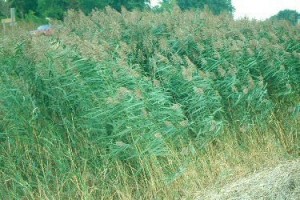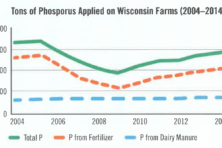The Lake’s Low So I’ve got More Land: What Can I Do with It?
- Share
- Tweet
- Pin
- Share

Shoreline property owners can pull invasive species like phragmites, pictured, by hand, but have to get a permit from the Department of Natural Resources to use a machine like a weed whacker on the shore.
For shoreline property owners, the low level of Lake Michigan is a particularly perplexing problem. Areas of their backyard that would normally be submerged are now completely dry, and there’s a question of what exactly a property owner can do with any of that “new” land.
“It generates a lot of questions because people commonly think, if the water’s way down, is that my land or not?” said Heidi Kennedy, Shoreland Policy Coordinator with the Wisconsin DNR’s Bureau of Watershed Management.
The answer, essentially, is no, but there’s still a lot you can do on the newly exposed property. If you just want to pick up trash, go ahead. If you want to cut out some invasive species by hand, that’s completely fine. But if you want to take a motorized piece of equipment, like a lawn mower or weed whacker, down to the former lake bed, that’s when you’d have to start talking to the DNR.
“If you’re removing vegetation just by hand you can do that without approval,” said Kennedy. “If you want to use motorized equipment you have to get a permit.”
Landowners also have to get a permit to conduct any sort of potentially disruptive project – such as building a boathouse, putting in a new line of rocks to protect against erosion, or dredging their dock – that takes place below the Ordinary High Water Mark.
The Ordinary High Water Mark is defined as “the point on the bank or shore up to which the presence and action of the water is so continuous as to leave a distinct mark either by erosion, destruction of terrestrial vegetation or other easily recognized characteristic.” But while the lake itself may be low, don’t expect your property’s Ordinary High Water Mark to necessarily match the current lake level.
“They technically only own up to the Ordinary High Water mark and just because the water is out it doesn’t mean that high water mark has moved yet,” said Mariah Goode, head of the Door County Planning Department. “People have called us and asked when the mark’s going to be moved, but there’s not one set factor telling us where that mark is.”
“The DNR has to determine where that Ordinary High Water Mark is located and that can be difficult because Lake Michigan is a difficult system,” said Kennedy. “It takes a long time to change an Ordinary High Water Mark.”
The DNR’s website contains a list of general permits landowners can fill out for a variety of projects, which can be found by heading to the DNR site, dnr.wi.gov, and searching “General Permits”. The application fee for general permits is $303. If your project doesn’t meet the guidelines for a general permit (which are different depending on what type of project you’re looking at), you can apply for an individual permit asking the DNR to grant an exemption from the normal guidelines. The application fee for an individual permit is $603.


